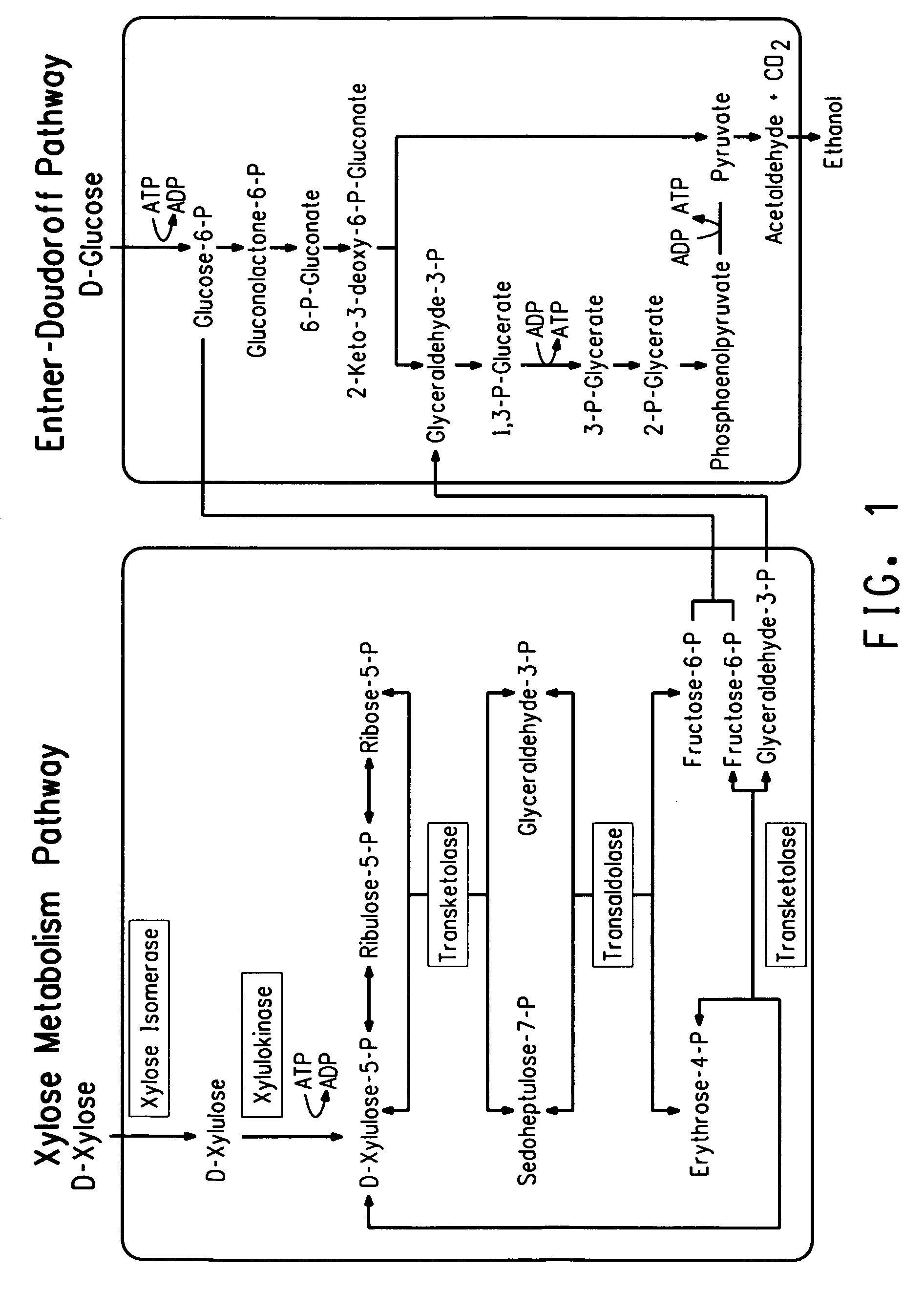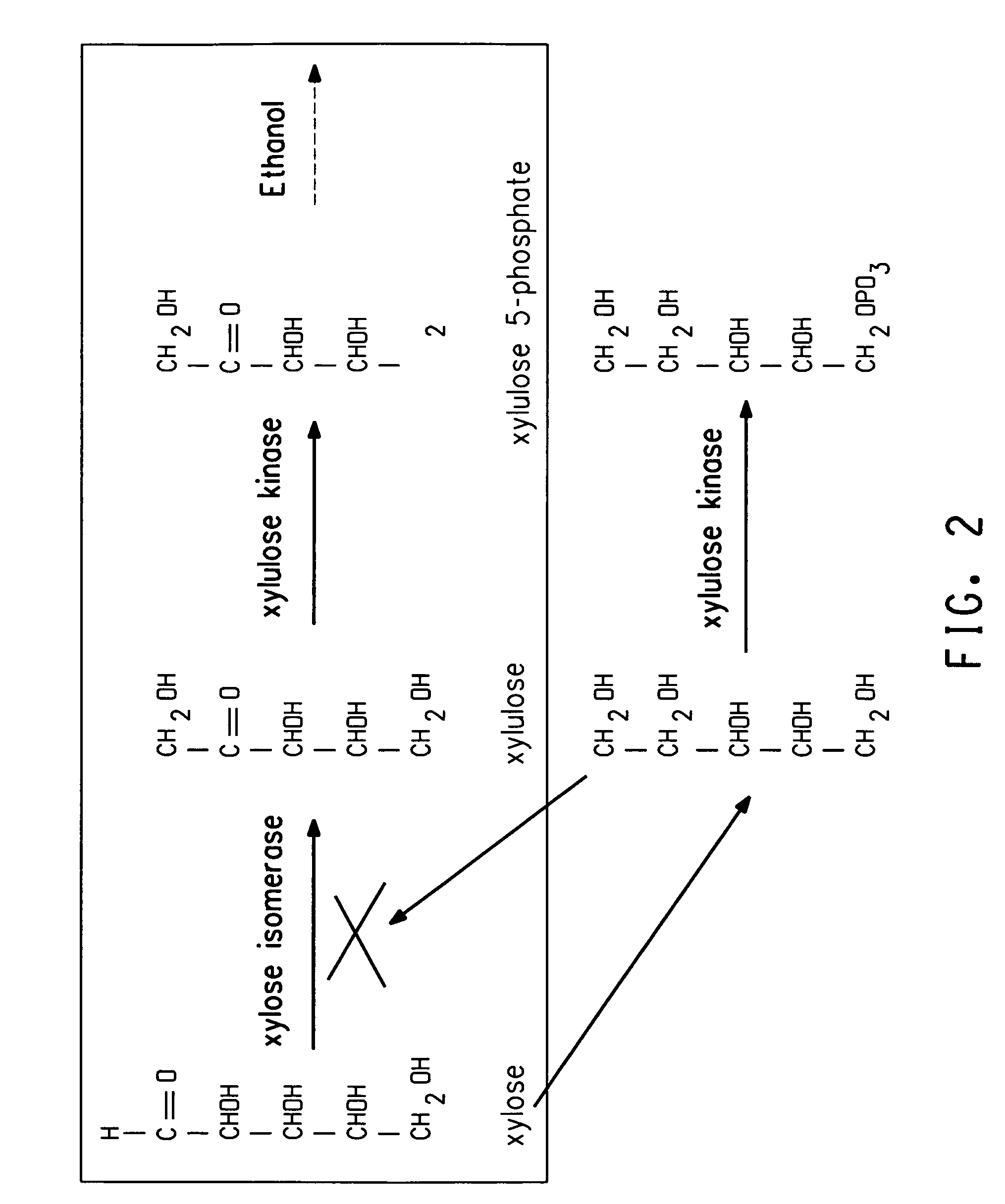Xylitol synthesis mutant of xylose-utilizing zymomonas for ethanol production
a technology of xylose and zymomonas, which is applied in the field of microorganisms and genetic engineering, can solve the problems of osmotic shock, xylitol synthesis also reduces the yield of ethanol, and strains do not grow and produce ethanol as well on xylose as on glucose, so as to reduce the amount of xylitol, increase the production of ethanol, and reduce the amount of xylito
- Summary
- Abstract
- Description
- Claims
- Application Information
AI Technical Summary
Benefits of technology
Problems solved by technology
Method used
Image
Examples
example 1
Construction of ZW658, a Xylose-Fermenting Zymomonas mobilis Strain
[0151]ZW658 was constructed by integrating two operons, PgapxylAB and Pgaptaltkt, containing four xylose-utilizing genes encoding xylose isomerase, xylulokinase, transaldolase and transketolase, into the genome of ZW1 (ATCC #31821) via sequential transposition events, and followed by adaptation on selective media containing xylose. Previously, a xylose-fermenting Zymomonas mobilis strain called 8b was constructed, as described in United States Patent Application 20030162271, by integrating the two operons PgapxylAxylB and Penotaltkt, along with selectable antibiotic markers, into the genome of Zymomonas mobilis 5C via a combination of homologous recombination and transposon approaches followed by adaptation and NTG mutagenesis. In the preparation of ZW658, transposition (Epicentre's EZ::Tn in vitro transposition system) was used, as opposed to site specific homologous recombination, because this approach offers the a...
example 2
Fermentation Evaluation of Top Improved Xylose-Utilization Strains at 37° C.
[0169]The following example illustrates the fermentation performance of the improved xylose-utilizing Zymomonas strain ZW658 under fermentation conditions that mimic the sugar concentrations and the acetic acid level expected in a biomass hydrolysate. Strain ZW658 was inoculated into fermentors containing RM medium supplemented with 10% glucose (RMG10%), 8% xylose (RMX8%), 10% glucose+8% xylose (RMGX10%8%) and 10% glucose+8% xylose+0.6% acetic acid (RMGXAc10%8%0.6%), respectively. All fermentations were conducted in Sixfors with 300 ml media at 150 rpm, pH5.5 and 37° C. Nitrogen was purged through the media in the fermentors overnight and stopped right before inoculation. No nitrogen was purged during the fermentation. Inocula for the fermentation were prepared with RMGX(10%, 4%) at 37° C. in shake flasks (150 rpm) after reviving of the working stocks in RMG5%. Strain 8b was used as a control under the same ...
example 3
Preparation of a Suicide Construct for Insertional-Inactivation of the Glucose-Fructose Oxidoreductase (GFOR) Gene in ZW1 and ZW658
[0171]The suicide construct used to knockout the gene encoding glucose-fructose oxidoreductase in ZW1 and ZW658 (“GFORSp-9WW”) was derived from another suicide construct (“pLDHSp-9WW”) that was used previously to insertionally-inactivate the gene for D-lactate dehydrogenase in Z. mobilis using host-mediated, double-crossover, homologous recombination and spectinomycin resistance as a selectable marker. pLDHSp-9WW was also derived from a number of other constructs that were previously generated. The initial precursor for all of these constructs was the plasmid vector pNEB193 (NEB #N3051S; New England Biolabs). This plasmid was chosen because it can replicate in E. coli but it cannot replicate in Z. mobilis. All of the steps and intermediates that were involved in generating the GFOR knockout construct are described below in chronological order starting wi...
PUM
| Property | Measurement | Unit |
|---|---|---|
| concentrations | aaaaa | aaaaa |
| concentration | aaaaa | aaaaa |
| concentration | aaaaa | aaaaa |
Abstract
Description
Claims
Application Information
 Login to View More
Login to View More - R&D
- Intellectual Property
- Life Sciences
- Materials
- Tech Scout
- Unparalleled Data Quality
- Higher Quality Content
- 60% Fewer Hallucinations
Browse by: Latest US Patents, China's latest patents, Technical Efficacy Thesaurus, Application Domain, Technology Topic, Popular Technical Reports.
© 2025 PatSnap. All rights reserved.Legal|Privacy policy|Modern Slavery Act Transparency Statement|Sitemap|About US| Contact US: help@patsnap.com



